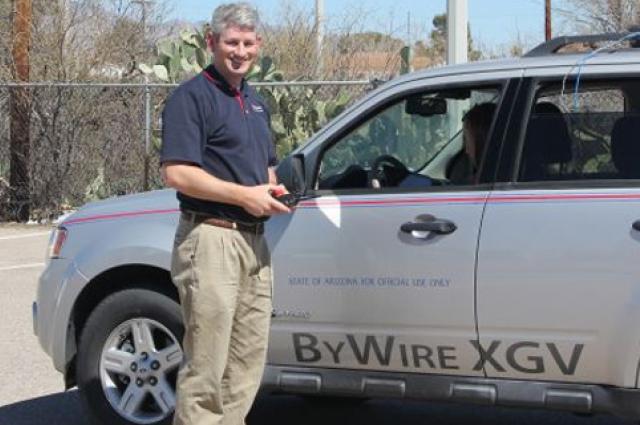ECE’s Jonathan Sprinkle Earns Career Award, Explores New Models in Cyberphysical Systems
Ask the UA’s Jonathan Sprinkle about recently winning a prestigious National Science Foundation Career award, and he’s likely to tell the story about an AutoCAD program and milling machine that came to his high school. The machine had nothing to do with the cyberphysical systems work for which Sprinkle is being recognized but everything to do with where he is today.
The computer numerical control mill was set up to produce a single, flat Plexiglas key chain based on each student’s computer-aided drawing. But Sprinkle and a friend hacked the software and reset the machine to cut a 3-D figure of a sports car then output dozens of copies. More importantly, the experience propelled Sprinkle into the world of engineering.
"I never would have been an engineer if that $500,000 key chain maker had not come to my high school," he said.
That’s why as part of his research, Sprinkle, an assistant professor in the electrical and computer engineering department, will give the keys of a full-size robotic car, or autonomous ground vehicle, to high school students so they can test new cyberphysical systems modeling techniques intended to guarantee safe operation of the vehicle.
"By involving students in the design of behaviors of the vehicle, the project exposes scientists and engineers of tomorrow to societal-scale problems and tools to address them," said Sprinkle.
The National Science Foundation Career, or Early Faculty Development, Award is the NSF’s most prestigious honor for junior faculty members who demonstrate outstanding research, excellent education, and the integration of education and research within the context of the mission of their organizations. Sprinkle’s award includes a $460,000 grant over five years, beginning May 1, to support his educational activities and research.
"He is a rising star on the national engineering scene, and his work is at the forefront of thinking about systems that run themselves,” said UA College of Engineering Dean Jeff Goldberg. "This project will help bring to fruition futuristic ideas such as cars that drive themselves, mobile patient monitoring and treatment devices, and border security systems."
In highly interconnected and complex ways, cyberphysical systems integrate computers with the real world. They enable us to control things in our home while we are away, invent new kinds of medical monitors and treatments, and expand our air transportation capabilities. They have to be able to communicate in real time and predict how long computations will take. Unfortunately, that’s much easier to say than do.
"We know how to build cyberphysical systems, we just do not know how to build them in an efficient, cost-effective way," said Sprinkle, adding, “Almost all large cyberphysical systems projects go over time and over budget.”
Because of the complexity of cyberphysical systems, traditional modeling and analysis tools are unable to effectively predict system behavior. Each cyberphysical system, with its complicated mix of controls, communications and computations, must be built from scratch, and problems most often are not identified until the testing phase, which can send developers back to the drawing board well into the process.
The goal of Sprinkle’s research is to make it easier to build cyberphysical systems by using new kinds of programming languages that are based on graphical models. The research will attempt to find problems that are normally identified in the testing phase much earlier, and the tools he and his team create will automatically change the graphical models to fix the problems.
The UA’s robotic car will serve as a test bed for the new modeling techniques, coming into play in the final stages of the project. By the time the students, many of whom are not even old enough to drive, get the keys to the robotic car, the new modeling techniques are expected to ensure safety.
"We want to build models so that we know by the time the models verify themselves that they are going to be safe," Sprinkle said. "I know the students are going to use the car safely because we are only going to allow them to generate safe code."
Here’s how it will work: A few dozen 10th-graders from Tucson’s Flowing Wells and Sabino Canyon high schools will write computer code that controls certain aspects of the car’s performance, such as how it maneuvers around a slalom-like course marked by cones. Sprinkle’s code-verification software will ensure safety constraints, such as velocity, steering angle and distance from cone before the car can even start its engine. The research team is pursuing additional grant funding, with the aim of involving more schools in the project.
Satisfying these sorts of task-specific design requirements in cyberphysical systems is critical for tomorrow's societal technologies such as smart buildings, smart power grids, home health care, and water management, Sprinkle explained.
"Dr. Sprinkle draws from a wealth of knowledge in several fields -- control systems, embedded systems, wireless technologies and biomedical systems -- to create something unique," said Tamal Bose, head of the UA’s electrical and computer engineering department. "His exemplary teaching, research advancements, and development innovations, make this NSF Career Award well-deserved."


